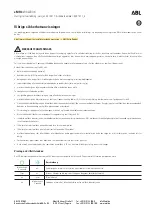
WARNING: Do not use replacement tires with lower load
carrying capacities than the originals because they may lower
the vehicle’s GVWR and GAWR limitations. Replacement tires
with a higher limit than the originals do not increase the GVWR
and GAWR limitations.
WARNING: Exceeding any vehicle weight rating limitation
could result in serious damage to the vehicle and/or personal
injury.
Steps for determining the correct load limit:
1. Locate the statement “The combined weight of occupants and cargo
should never exceed XXX pounds” on your vehicle’s label.
2. Determine the combined weight of the driver and passengers that
will be riding in your vehicle.
3. Subtract the combined weight of the driver and passengers from
XXX kilograms or XXX pounds.
4. The resulting figure equals the available amount of cargo and
luggage load capacity. For example, if the “XXX” amount equals 635
kg (1400 lbs.) and there will be five 68 kg (150 lbs.) passengers in
your vehicle, the amount of available cargo and luggage load capacity
is 650 lbs. (1400–750 (5 x 150) = 650 lbs.). Metric conversion; 295
kg (635–340 (5 x 68) = 295 kg).
5. Determine the combined weight of luggage and cargo being loaded
on the vehicle. That weight may not safely exceed the available
cargo and luggage load capacity calculated in Step 4.
6. If your vehicle will be towing a trailer, load from your trailer will be
transferred to your vehicle. Consult this manual to determine how
this reduces the available cargo and luggage load capacity of your
vehicle.
Special loading instructions for owners of pickup trucks and
utility-type vehicles
WARNING: For important information regarding safe operation
of this type of vehicle, see the Preparing to drive your vehicle
section in this chapter.
2005 Mazda Tribute
(j14)
Owners Guide (post-2002-fmt)
USA English
(fus)
Driving
143
















































